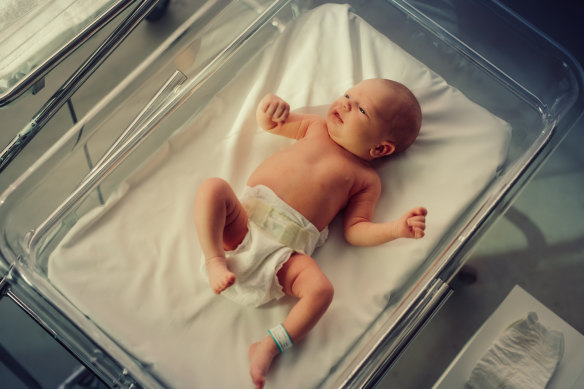- Exclusive
- National
- NSW
- Healthcare
Too old to push: Record rate of NSW women having caesarean births
By Mary Ward
Women are having caesarean births at a record rate in public and private hospitals statewide, new data shows, with older mothers driving the trend rather than women being “too posh to push”.
The proportion of women having vaginal births without intervention across the public and private system fell to 50.2 per cent in 2022, data from NSW Health’s annual Mothers and Babies report, published last month, shows.

An increasing proportion of women are giving birth via caesarean. Credit: Getty Images
Meanwhile, the caesarean section rate has again risen: 49.4 per cent of private maternity patients gave birth via caesarean in 2022, an increase from 43.9 per cent in 2018.
Public caesarean births have also increased, from 29.8 per cent to 33.6 per cent of patients.
The report follows the recent NSW Birth Trauma Inquiry, which focused heavily on physical and psychological injury following birth interventions.
Western Sydney University professor and leading midwifery academic Hannah Dahlen said the rising rates of caesarean births had been of concern to midwives for many years because of their impact on women’s health.
Mothers who have a caesarean have a long recovery time and Australian Institute of Health and Welfare data suggests only 12 per cent will go on to have a normal vaginal birth.
“We are essentially saying that one in two women in a private hospital now have major abdominal surgery to have a baby,” Dahlen said.
“We can be very shortsighted in health. We are so focused on this current pregnancy, we do not think about the reproductive life course.”
Almost 40 per cent of births in private hospitals were elective caesareans, as opposed to emergency procedures.
In the Sydney and Northern Sydney local health districts, more than 30 per cent of women gave birth by elective caesarean in 2022, compared with only 16 per cent in northern NSW.
Fewer than half of women gave birth without any intervention in these two districts, as well as in the South Eastern Sydney district, which stretches from the city’s eastern suburbs to Sutherland Shire, and Murrumbidgee.
A NSW Health spokesperson said the rise in caesareans was being driven by elective, not emergency, procedures. Instrumental births – such as via forceps – have remained steady at 11 per cent of births.
“The reasons for caesarean sections and other maternity interventions are complex and multifactorial. These decisions are based on individual circumstances and are guided by the specific needs of the birthing woman and her baby,” the spokesperson said.
National Association of Specialist Obstetricians and Gynaecologists president Dr Gino Pecoraro said increasing age and BMI were the biggest reasons that women worldwide were having more caesareans.
The average age of a mother giving birth in NSW was 31.4 years in 2022, up from 30.9 years in 2018.
As well as being the most affluent parts of the state, Sydney’s central, northern and eastern districts also had the highest numbers of women giving birth aged over 35.
Pecoraro said more women needing assistance to fall pregnant and having comorbidities, as a result of their age, had also increased caesarean rates.
“And then we have the fact that the risk appetite of the population is changing. Their tolerance for something not going to plan or having an adverse outcome is decreasing,” he said.
He said the high rates of caesareans in private hospitals were driven by women seeking out this type of birth when going to a private hospital.
“Women used to have six or seven babies, now they have one or two. Caesareans have an increased risk for a mother but decreased for their babies.”
Dahlen said women could choose to have caesarean deliveries, but she said the heart of the issue was the medicalisation of birth, and giving women the best chance of a vaginal birth in the future.
“In all the studies we have done, the vast majority of women want to have a vaginal birth. Women who have a caesarean that isn’t planned or expected have higher rates of birth trauma,” she said.
The prevalence of birth trauma in Australia is difficult to quantify. A 2022 study said one in 10 women suffered birth trauma. However, the survey was not population representative, as participants were recruited on social media and at screenings of a documentary about birth trauma.
The state government is yet to respond to the findings of a parliamentary inquiry on birth trauma, released in May.
Its 43 recommendations heavily favour midwife-led care and include consent training for health practitioners, investment in continuous care and the appointment of a chief midwifery officer.
The inquiry attracted criticism from the Royal Australian and New Zealand College of Obstetricians and Gynaecologists for using terms such as “obstetric violence”, which it said was an unfair characterisation of injuries that can occur while delivering life-saving care.
Health Minister Ryan Park thanked women, families and clinicians for showing courage in participating in the inquiry, and said his government was carefully considering its findings.